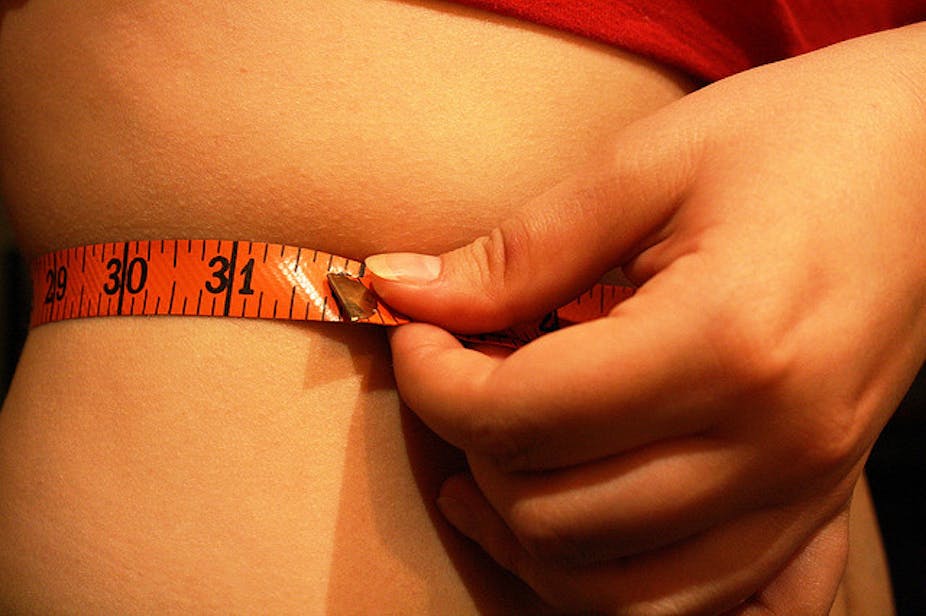Welcome to part two of The science behind weight loss, a new Conversation series in which we separate the myths about dieting from the realities of exercise and nutrition.
Here, Michael Vagg, Clinical Senior Lecturer at Deakin University’s School of Medicine and Pain Specialist at Barwon Health, takes a light-hearted look at the weight-loss industry:
In our battle with excess weight, Australians spend more than $790m a year on weight-loss products. Many are based on shortcuts that seem to allow users to maintain their existing calorie intake or avoid getting active and still achieve their goal weight.
Manufacturers of these pills, potions, liquids, magnets and devices play on consumers’ desire to look and feel better about themselves, knowing that this desire is so great that it’s not hard to convince many to overlook science and common sense and give the products a go.
So how do these products make their way to our shelves and online stores?
Well, surprisingly easily – you don’t even need a product that works. Just follow this (tongue-in-cheek) four-step guide, and human psychology will do the rest.
Step 1: Get yourself an angle
There are several approaches you can use, depending on your scientific literacy, your target market and how much you have to spend.
You have to differentiate your product from the competitors, while guaranteeing you can still operate with low overheads and have the potential to draw in long-term users.
If you’re aiming at the “miracle cure” market, you can make your product as absurd or wacky as you want.
Take some cues from existing products such as these FatBlaster Reducta and Fat Magnet tablets, which claim to use a magnet to help draw the fat out your intestine.
You could take the easy way and select any of the ingredients which the Therapeutic Goods Administration (TGA) has already pre-approved as low risk, just as this manufacturer did for its “Mega slim” product. As long as you choose from the list of low-risk ingredients, it’s likely you’ll be able to get your product listed.
If you want to be more sophisticated, you can have a look through the science journals for a little-known, highly technical animal study. You can then extrapolate wildly from the findings of the research, given very few of your prospective consumers will check the references you quote.
Deriving phoney claims from real but obscure science is an excellent way to satisfy the TGA requirement that you “hold evidence” your product aids weight loss.
In addition, this approach will take the watchdog a bit more time and effort to debunk, and you may be able to persuade a health professional or two that your claim is plausible (especially if you make them a franchisee!)

Step 2. Market your product with both barrels
You can get real people to believe in your bogus product quite easily if you know a bit about psychology.
Testimonials are key, and despite the Australian Health Practitioner Regulation Authority (AHPRA) and TGA restricting their use, you should roll them out relentlessly until you are ordered to stop.
The penalties are light-to-non-existent and consumers will believe a breathless informal recommendation over a scientist in a lab coat any day.
Marketing unreliable products is easier to defend if you use hints and implied truths rather than telling outright lies.
The “one amazing tip for a flat belly” style of online ad is a good example. Draw people in with curiosity, then make them wade through stacks of information to find your real claims. It’s harder for them to back out if they’ve invested time and effort finding out about it.
The feeling of having insider knowledge is a powerful way of increasing a consumer’s belief in a product, so make your pill or potion seem exotic, amazing, exclusive, secretive and generally mysterious. This is one reason why “miracle superfoods” such as goji berries are a sure winner.
This effect is further enhanced by making sure you mention that mainstream health professionals such as dieticians and doctors are “amazed”, “jealous” or even “baffled” by the therapy. And it ensures you won’t be judged by the rigorous standards demanded of credible, registered health-care professionals.
Step 3. Team your product with a reduced-calorie diet
Tell consumers your supplement “cannot be taken with certain foods” or “only works if you reduce carbs and fat”.
Your customers will achieve weight loss by eating less, so the content of the product doesn’t matter if you can get them to perform the required behaviour: to eat less and move more.
You can even claim the supplement works only if you maintain a very low-calorie diet.
Step 4. Don’t sweat it
If your product does attract complaints, you can try denying that it’s a therapeutic product.
Regardless of what the regulators may order you to do, you can just keep on selling and marketing until they shut you down. This is expensive and time-consuming for them, and you can obstruct the process simply by starting some legal action.
So there it is – a simple, almost foolproof guide to setting up your own weight-loss scam. Have a profitable day.
This is the second part of our series The science behind weight loss. To read the other instalments, follow the links below:
Part One: Diets and weight loss: separating facts from fiction
Part Three: Feel manipulated? Anxious? Tune out the hype and learn to love your body
Part Four: Food v exercise: What makes the biggest difference in weight loss?
Part Five: An online tool to help achieve your weight-loss goal (no, it’s not a fad diet)
Part Six: Ignore the hype, real women don’t ‘bounce back’ to their pre-pregnant shape
Part Seven: Quick and easy, or painful and risky? The truth about liposuction
Part Eight: Weight loss and the brain: why it’s difficult to control our expanding waistlines
Part Nine: Are diet pills the silver bullet for obesity?
Part Ten: Want to try the latest fad diet? Just ask your local pharmacist

